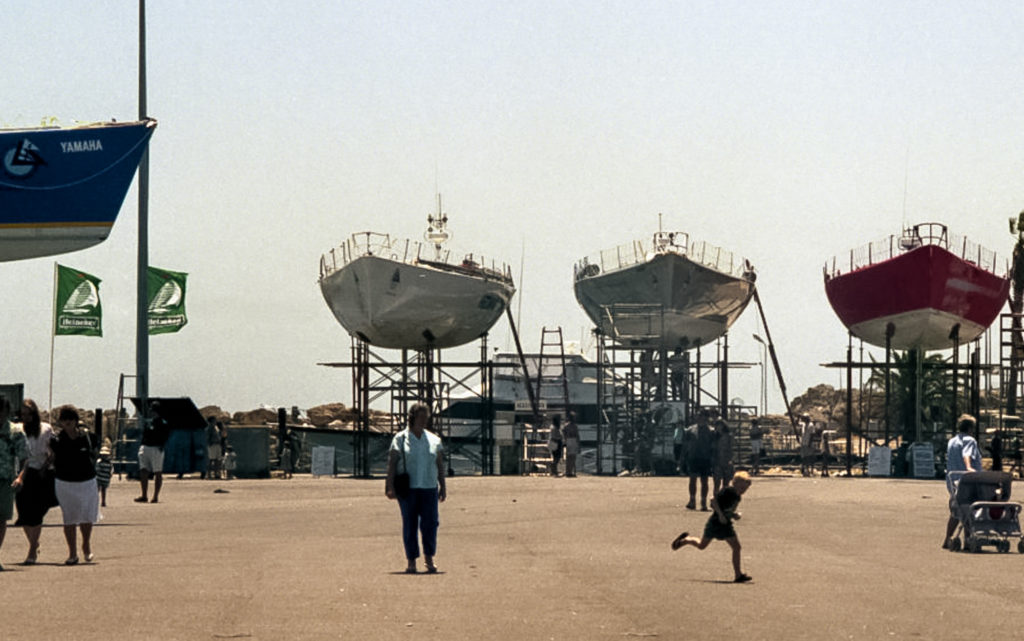One night last week, I’d had a bad night’s sleep, broken by rain pounding on the roof. There were also sheets of wind-blown water crashing over the side of the house. I knew I wasn’t on a leg across the roaring forties in a round-the-world yacht race because the bed wasn’t rocking. But I wondered about the strength of water, the power of the ocean while remembering the damage I’d seen on the keels of maxi yachts on a hard stand in Fremantle. And the cataclysmic noise just above my head simultaneously prompted thoughts about the end of time, which for us as individual sailors, would be the same as the end of our lives.

Yachts
It was December 1993, probably on a Sunday that I visited the huge ocean racing yachts in Frio. The very battered 1993–1994 Whitbread Round the World Race competitors had come from Uruguay, arriving over several days. They were surprisingly led in by the newly built Whitbread 60 class Intrum Justitia. The race finished back at the starting line in Southampton and was ultimately won by NZ Endeavour skippered by Grant Dalton, a race dominated by the huge Maxis.
While most keels and masts had been taken off the yachts, one holed keel in particular had impressed me. Several of the visible keels were seriously damaged but the one with a hole the size of my head was scary. The hole was, presumably, punched through the leaden keel by a submerged log. And we heard that the crew knew nothing about it.
New Zealand Endeavour looked peculiar to us back then. The bow of the 25 metre ketch had an elegant stretch to it, the mizzen was very far forward, the main mast very far back. But we’ve got used to seeing extremes of engineering and materials since offshore racing attracted prestige and huge funding. It’s still amazes me that of the 30,000 people who were in Wellington to watch NZ Endeavour launch (and that’s an amazing number), that I’ve since met a few Wellingtonians who swear they were among them. Now called the Volvo Ocean Race, New Zealander Bruce Farr’s designs won the Whitbread in 1986, 1990, 1994 and 1998.
Leaks
It’s hard not to listen out for leaks when it’s only been a few days since one of our daughters had a roof leak repaired. And besides, the ridge line above my bed had failed once before, a string of drips waking us years ago as water fell from the ceiling as yet more flowed out from the bedside electric sockets.
Lia very kindly brought me a cup of coffee and encouraged me to read in bed for awhile. She turned on the bedroom light, joking that it would make it dark outside.
I remembered a joke by Ken Dodd. He asked that somebody would close a window because it was cold outside. One of his Diddymen replied that closing the window wouldn’t make the outside any warmer.
Bacteria
Brian Greene tells a story, in the last chapter of his wonderful book, Until The End of Time, of an elderly woman who chided him for running roughshod over what she described as an essential need we all have for the species to continue. ‘Which news would affect you more’ she asked ‘being told you have a year to live or that within the year Earth will be destroyed?’
Sometimes, a change of perspective is very informative. We seem to think, we humans, that the world revolves around us. Once upon a time, it was considered sacrilegious to think, let alone say, that the earth revolved around the sun. Today, we know that our lives on this planet depend on many things being ‘just so’. But for all that we know, we don’t know how to stop a single celled virus from killing us. Nor do we know how we’d survive without bacteria. Indeed, perhaps it’s the bacteria that are the rulers of the universe and that we are just very complex machines that will assist them to leave earth and spread across the cosmos.
As Greene writes ‘Whereas most life, miraculous in its own right is tethered to the immediate, we can step outside of time.’

Wondered if you had ever come across boats by the husband of a friend who has a home in England near Westonbirt. Dick Carter. He was a boat designer. He published a book “Dick Carter Yacht Designer in the golden age of offshore racing.”
My father raced and cruised a beautiful Dick Carter designed boat, built in Burnham On Coach in Dunlaoire. She was a beautiful 33ft racer called Angel (of Islington).
I am very happy to see artists making connections through beautiful boats.
After seeing There Will Be No Miracles Here hanging in Chelsea all those years ago, we are looking forward to seeing miracles hanging in Collioure at PRESSEVERTE!
Good luck with the new gallery!
PS My father brought the first Glen to Dun Laoghaire and upset the class naming convention by calling her Pterodactyl. That was 1950, I think. The new owners kindly took him out for a sail on her 50 years later. And though he’s gone, Pterodactyl can be seen on the water every summer.